The Best 49 Key MIDI Controller Keyboards 2024
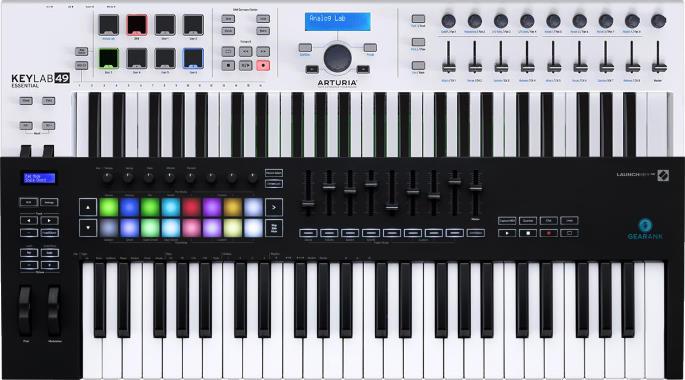
Novation Launchkey 49 MK3
Cons
- Overly light feeling keys
- You have to move the knobs to activate them - not touch activated
Pros
- Tight and unmatched integration with Ableton in the 49-Key MIDI controller space
- Fun and expansive Built-in Arpeggiator, scale and chord functions that also work with hardware
- Sleek and modern design
The Novation Launchkey 49 MK3 represents the third iteration of the well-loved Launchkey series by Novation - a MIDI keyboard controller specifically designed to work with Ableton Live.
The 49-key version is the smallest Launchkey that features 9 faders and buttons below them. 8 of which are customizable with the last set representing the master volume and arm/select respectively.
It's a controller that feels familiar, yet refined - and with lots of new features.
Compositional tools like new scale and chord modes, better custom mapping, as well as a 5-pin MIDI out for controlling hardware synths, are some of the new features in the MK3 version.
You can also launch clips and scenes with the RGB pads that change color to correspond to your assigned colors in Ableton. The pads are also larger in the Mk3 than in the older models - something, as a finger drummer I appreciate a lot.
It does have a very light keybed feel, even lighter than the Arturia Keylab Essential 49. But based on the feature set, acoustic pianists are not really the main target market of this keyboard controller. Aside from the light feel, the response is quite okay and I should get used to it after a bit more practice. Aftertouch is lacking on this controller but I suspect that has contributed to its very fair price.
One minor gripe I have though is that the knobs are not touch activated. You have to rotate the knob to activate it, which is something I think Novation should look into for mark 4.
The new features as well as the minor improvements introduced with the MK3 I gladly welcome over the mark 2. I like the new compositional tools such as the scale mode as it helps my songwriting and productivity. The price was also a surprise for me as the new version remains of great value.
If you're an Ableton Live user, the included Ableton Live Lite makes the Novation Launchkey 49 MK3 a great pick. It lets you launch clips and compose without the need for extra hardware.
Tech Specs
- Keys: 49 velocity-sensitive synth action keys
- Pads: 16 x RGB, Velocity-sensitive Pads
- Arpeggiator: Yes
- Motorized Controls: No
- Bundled Software: Ableton Live Lite, Virtual Instrument, and Sample Plug-in Bundle
- Power: USB powered.
- Connectivity: USB and TRS input for sustain pedal.
- Control Hardware Directly: Yes; 5-pin MIDI out
- Compatibility: Mac OS X 10.11 or later + Windows 7 SP1 or later
- Dimensions: 31.06" x 10.16" x 3.03"
- Weight 6.68 lbs.
| Website | Source | *Rating Value |
| Sound On Sound | Robin Vincent | 90/100 |
| MusicTech | Alex Cummings | 90/100 |
M-Audio Oxygen Pro 49 49-key MIDI Keyboard Controller
Cons
- No built in support for Cakewalk
- Included software could be better
Pros
- Excellent key response feel and great modulation
- Plenty of features and very flexible with good solid mod wheels
- Compact and well-built
The M-Audio Oxygen Pro 49 is a 49-key MIDI controller that offers a range of features for music production, performance, and recording. It comes with velocity-sensitive keys, assignable knobs, faders, and pads, as well as smart chord and smart scale modes, a backlit LCD screen, and an expression or sustain pedal input. The controller seamlessly integrates with popular DAWs like Ableton Live, Logic Pro, and FL Studio. It offers auto-mapping functionality to ensure that its controls are pre-assigned to essential functions within your software.
The Oxygen Pro 49 boasts a sturdy build with a sleek design, and its keys are responsive and comfortable to play. The control knobs and faders have a tactile feel, making them enjoyable to use during extended sessions. The MIDI controller also comes with a comprehensive software bundle, including Pro Tools | First, Ableton Live Lite, and Velvet, a virtual instrument with classic electric pianos and keyboards.
Pros of the Oxygen Pro 49 include its excellent key response feel and great modulation, plenty of features and flexibility, and solid build quality. Users appreciate the extensive controls, pre-mapped options for popular DAWs, and various execution modes.
However, some cons to consider include no built-in support for Cakewalk and the typical Air Music VST instruments included in the software bundle.
Overall, the M-Audio Oxygen Pro 49 offers a solid platform for creativity with its responsive keys, extensive controls, and thoughtful features.
Specifications
- Keys: 49 velocity-sensitive, semi-weighted keys with aftertouch and assignable zone
- Pads: 16 x RGB Backlit Velocity-Sensitive Pads
- Arpeggiator: No
- Motorized Controls: No
- Bundled Software: Akai MPC Beats, Ableton Live Lite, AIR Music Tech virtual instruments
- Power: USB bus powered (cable included)
- Connectivity: USB
- Control Hardware Directly: No
- Compatibility: OS X 10.11.6 or later (macOS 10.13.6 for Pro Tools First) + Windows 7 SP1 or later (Windows 10 build 1909 for Pro Tools First)
- Dimensions: 3.3" x 31.5" x 10.4"
- Weight : 9.3 lbs.
M-Audio Keystation 49 MK3 49-Key MIDI Keyboard Controller
Cons
- Has a bit of a learning curve for the advanced features
- Key quality could be better
Pros
- Keys feel great while playing
- Portable
- Plug and play. Easy to get started
The M-Audio Keystation 49 MK3 is a reliable and straightforward MIDI controller designed for musicians, producers, and beginners. It features 49 full-sized keys that offer a comfortable playing experience with velocity-sensitive keys. The design is streamlined, lacking in any bells and whistles, but excels at its core function. The pitch bend and mod wheels are wide, allowing for expressive control, and the basic transport controls reduce mouse clicks, simplifying your workflow. The directional buttons facilitate navigation within your DAW or plugins. The keys feel responsive, and the overall construction is sturdy, inspiring confidence. It’s lightweight and portable, making it suitable for both studio and live setups.
One of the pros of the M-Audio Keystation 49 MK3 is its black textured color that is visually appealing. The changing color LEDs on the transpose buttons are also a nice touch. The feel of the keys is really nice, and the velocity feels realistic compared to a piano. The keyboard is fairly light to carry around, making it portable. It is also plug-and-play, taking less than two minutes to get it out of the box, plug it in, and be up and running with 49 keys.
On the downside, getting used to the Keystation 49 MK3 has a bit of a learning curve. With regards to build quality, the keys are a little fragile.
Overall, if you’re looking for a reliable and affordable MIDI controller with essential features, the M-Audio Keystation 49 MK3 is a solid choice.
Specifications
- Keys: 49 full-size, velocity-sensitive, synth action keys
- Pads: No
- Arpeggiator: No
- Motorized Controls: No
- Bundled Software: AIR Music Mini Grand/Velvet/Xpand!2, Ableton Live LIte, Skoove, Touch Loops, Melodics Tutorial
- Power: USB bus powered
- Connectivity: USB and TRS input for sustain pedal.
- Control Hardware Directly: No
- Compatibility: Mac OS X 10.6 or later + Windows 10, 8, 7 and Vista.
- Dimensions: 32.36" x 7.44" x 2.68"
- Weight : 4.72 lbs.
Nektar Impact LX49+
Cons
- Build quality and materials could be better but would possibly increase the price.
Pros
- Decent sliders and knobs
- Flexible mapping
- "Pad Learn" feature a welcome addition at this price
- Great pad sensitivity and response
The Nektar Impact LX49+ is a cost-effective MIDI controller offering comprehensive music production functionality. With a 49-key velocity-sensitive keyboard, the controller provides a responsive playing experience, making it an excellent choice for both beginners and experienced users.
The controller has various controls, including pitch and mod wheels, octave and transpose buttons, nine 30mm sliders, assignable buttons, transport controls, and eight velocity-sensitive pads with customizable LED colors. The controls have a solid build quality and a satisfying tactile feel, making the controller a pleasure to use.
It connects to your computer or iPad (with a connection kit) via USB, and it even has a low-power mode to extend battery life when used with a laptop or iPad. The LX49+ seamlessly integrates with popular DAWs, eliminating the need for additional plugins or wrappers. The sliders, buttons, and pads also allow for flexible customization, making the controller a powerful tool in the studio.
The included software bundle, which includes Pro Tools | First, Ableton Live Lite, and Velvet, enhances your music production capabilities. However, it's worth noting that the medium-weighted keys lack the overall quality of the other controls.
The Nektar Impact LX49+ is a straightforward and cost-effective approach to MIDI control. It offers tight DAW integration, solid construction, and comprehensive controls, making it a valuable addition to any studio setup.
Specifications
- Keys: 49 velocity-sensitive synth action keys
- Pads: 8
- Arpeggiator: No
- Motorized Controls: No
- Bundled Software: Bitwig 8-Track (VST plug-in compatible)
- Power: USB powered.
- Connectivity: USB and TRS input for sustain pedal
- Control Hardware Directly: No
- Compatibility: OS X 10.7 or later, iOS (Apple Camera Connection kit required for iPad) + Windows 7 or later
- Dimensions: 31.6" " x 10.5" x 3"
- Weight : 7 lb.s
Native Instruments Komplete Kontrol A49
Cons
- Needs deep dive to explore full potential
Pros
- Work well with MPC 2.10, Reason 12, and Ableton Live 11
- NI has informative walk-through videos of the keyboard's features
- The scale mode helps in composition
- The capacitive touch dials/knobs are very responsive
The Native Instruments' A-Series keyboards offer a blend of features and affordability, and the Komplete Kontrol A49 is a mid-range controller that fits well in this category. It is significantly more budget-friendly than the S-Series counterparts and provides excellent functionality. Although the A-Series lacks the Light Guides found in the S-Series, it is pre-mapped for KOMPLETE and NKS plug-ins and supports full VST integration. The custom NI keybed with 49 notes offers a solid playing experience.
The A49 integrates seamlessly with software such as Maschine, Logic Pro X, GarageBand, Live, and Cubase, and Nuendo integration is promised soon. While the A49 lacks features like touch strips and Light Guides, it still provides a quality playing experience at a fraction of the price of the popular S-Series.
The A49 MIDI keyboard controller has shown commendable compatibility with MPC 2.10, Reason 12, and Ableton Live 11, with no need to adjust settings to avoid latency issues. It offers a seamless connection experience, and its scale mode feature automatically maps the keys to the music scale of your preference. Additionally, there are extensive options beyond the conventional major, minor, or pentatonic scales. The capacitive touch dials/knobs are highly responsive to even the slightest touch, allowing for immediate modification of sounds and parameters.
However, to fully grasp its capabilities, some experimentation is necessary, and some of the software packages it requires are quite large, taking a significant amount of time to download. Nonetheless, given its remarkable features, the wait is worthwhile.
The Komplete Kontrol A49 is an excellent choice for musicians and producers who want to enhance their workflow without spending too much.
Specifications
- Keys: 49 velocity-sensitive semi-weighted keys
- Pads: No
- Arpeggiator: No
- Motorized Controls: No
- Bundled Software: Komplete Kontrol, Maschine Essentials, Komplete Instruments and Effects
- Power: USB bus powered
- Connectivity: USB and TRS input for sustain pedal.
- Control Hardware Directly: No
- Compatibility: MacOS 10.12 or later + Windows 10 Anniversary Update or later
- Dimensions: 32.3"" x 10.1" x 3.5"
- Weight : 7 lb.s
Arturia KeyLab 49 MkII
Cons
- Quite heavy for a 49-Key MIDI controller
Pros
- Road-worthy aluminum body
- Extended number of outputs and inputs, pads, chord banks
- Premium keybed with aftertouch based on the top-of-the-line Arturia MatrixBrute
The Keylab 49 Mark II takes what's great with the Keylab Essential 49 but adds more, more, more.
More tanky aluminum build, and premium keybed with aftertouch based on the top-of-the-line Arturia MatrixBrute. There are also lots more inputs and outputs, 4 extra pads, longer throw faders, additional chord banks, and more savable presets and controls.
But if you want the upgrades the Keylab 49 Mark II offers over the Keylab Essential you'll also have to pay more - over 2 times more. It also weighs over twice as much.
That's not to say this 49-key isn't worth it. Sporting more features across the board, those with a larger budget would be wise to look towards the Keylab 49 mark 2. One thing to consider though is the Essential is lighter and has a slightly more compact form factor. I can see some players prioritizing portability and compactness over better build quality and the added features that the Keylab possesses.
Like the Essential, the shining star of the included software is the latest version of Analog Lab, which has over 6,500 presets of pianos, organs, and of course - synths. This makes playing virtual instruments a breeze.
Additionally, it has a MIDI In apart from the MIDI Out, one CV input, and 4 CV outputs – pitch, gate, and two mod outputs which allow the Keylab 49 MkII to be a bridge between your hardware and computer forming the centerpiece of your hybrid studio setup.
It allows for pitch bend and other expressive note manipulation techniques.
If you want a premium 49-key MIDI keyboard controller that has all the niceties and works great with Arturia MIDI music software and hardware - get the Keylab 49 Mark 2. If you still want to be in the expansive universe of Arturia but want something more transportable, have a smaller budget, and don't mind taking a small hit in features and build quality - take a peek at the Essential 49.
Tech Specs
- Keys: 49 semi weighted keys, velocity sensitive with aftertouch.
- Pads: 16 x Back-lit RGB Performance Pads
- Arpeggiator: No.
- Motorized Controls: No
- Bundled Software: Arturia Analog Lab V Ableton Live Lite, Piano V 2, Arturia MIDI Control Center
- Power: 9V DC power supply (sold separately)
- Connectivity: USB, 1 x 1/4" (sustain), 1 x 1/4" (expression), 3 x 1/4" (aux), MIDI In/Out/USB, 1 x 1/8" (CV in), 4 x 1/8" (CV out, Gate out, Mod 1, Mod 2)
- Control Hardware Directly: Yes
- Compatibility: OS X 10.10 or later + Windows 7 SP1 or later
- Dimensions: 31.2" " x 11.7" " x 2.1"
- Weight 13.8 lbs.
| Website | Source | *Rating Value |
| Sound On Sound | Simon Sherbourne | 90/100 |
| Strong Mocha | Thorsten Meyer | 100/100 |
Native Instruments Komplete Kontrol S49 MK2
Cons
- Setup can be a bit time consuming
- No drum pads
Pros
- Dual screens great for navigating sounds
- Great control overview thanks to the dual screens
- Premium Fatar keybed
- Multiple controls enable in-depth live tweaking
- Great build quality
The Komplete Kontrol S49 MK2 is a MIDI keyboard and DAW control surface that seamlessly integrates with your digital audio workstation. The most notable feature of the S49 MK2 is the addition of two high-resolution screens that provide visual feedback and allow you to browse patches, view controls, and manage parameters directly from the keyboard.
This solid MIDI controller is built with high-quality materials and has a matte black finish that gives it a sleek appearance. The backlit rubber buttons ensure visibility even on dimly lit stages, and the pitch/mod controls are wheels that provide a tactile feel. The keybed, designed by Fatar, balances springiness and weight, making it a joy to play with.
The S49 MK2 simplifies track building and provides an efficient workflow for both seasoned producers and beginners. Thanks to its intuitive layout and seamless interaction with software, you can create entire tracks using just the hardware. The keyboard integrates seamlessly with your DAW, allowing you to assign transport controls, track levels, solos, mutes, and more from the hardware directly. The quick startup time and hassle-free integration into existing sessions are impressive.
The S49 MK2 is highly recommended for experienced dance music producers due to its combination with the Komplete Kontrol software, which is tough to beat. The keyboard has real-time dials and color menus, simplifying sound design and editing. The Fatar keybed rivals the quality of premium synthesizers and feels better than any other MIDI controller.
While the keyboard doesn't have drum pads, it's still worth considering due to its light, sturdy, and nice-looking build. The keyboard has great keys, responsive aftertouch, good wheels, and a touch strip. The jog/scroll wheel will only scroll in the project in MIDI mode, not "Mixer" mode, but this is a minor issue. Setup can be tedious, but it's well worth the time invested.
Overall, the Native Instruments Komplete Kontrol S49 MK2 is a versatile choice for musicians and producers who want a reliable keyboard controller that seamlessly integrates into their workflow.
Specifications
- Keys: 49 velocity-sensitive Semi-weighted Fatar Keybed
- Pads: No
- Arpeggiator: No
- Motorized Controls: No
- Bundled Software: Komplete Select, Komplete Kontrol (downloads)
- Power: 15V DC power supply (sold separately) / USB Bus powered
- Connectivity: USB and TRS (expression / sustain pedal inputs)
- Control Hardware Directly: No
- Compatibility: MacOS 11 or later + Windows 10 (64-bit) or later
- Dimensions: 3.3" x 33.1" x 11.7"
- Weight : 12.23 lbs.
Things to Consider When Buying A 49 Key MIDI Controller
-
Is 49 Keys enough for a MIDI Controller?
49 key MIDI controllers are the perfect size for home studio music production use. It provides enough notes for two-handed playing, while retaining a compact and portable profile. In case you do need to expand your octave range, they come with octave buttons that are usually easily accessible. This means that you can play most songs on a 49-key keyboard, but you'll have to adjust octaves from time to time. Note that it won't be enough for classical piano playing, and for quick piano runs across multiple octaves. But for everything else, a 49 key keyboard is good enough. Note that there are more portable and smaller MIDI controller keyboards, often used in conjunction with virtual instruments that include a synthesizer. -
What Do You Want To Control? If you only want to control computer software like FL Studio then all of the options above will do that, although some offer more control options than others. If you want to control external hardware, such as a stand-alone synth, then you'll need to get one that explicitly says it will do that - the ones that come with a 5-pin MIDI out port do that and we tell you above on each description whether or not it meets that need. If you already have a good MIDI usb keyboard piano, that can also work.
-
Software Integration. Thanks to USB, class compliant MIDI connectivity has become standard for most MIDI keyboard controllers. Most of the MIDI keyboards we recommend come with presets or automatic configuration options that make them easy to integrate with most major DAWs and recording software - sometimes you have to download some extra files from the manufacturer's website to do that. I've tried to indicate which major applications each keyboard integrates well with. But if you're unsure then feel free to ask about your particular software and the particular controller you're interested in. I or someone else here will advise you.
-
Transport Controls. These are dedicated buttons to control your DAW. It includes standard recording controls such as Play, Stop, Rewind, Fast Forward etc. They can be a very handy feature because you can keep your recording workflow going without having to reach for your computer mouse.
-
Motorized Controls. These are seriously cool, but usually only found on larger than 49 key controllers, but the Nektar Panorama P4 does have this feature. Another cool feature to look out for are touch strips, which would be perfect for those used to working with touch screens.
-
Key Size & Weight. Portability is a priority in this market segment, so the size and number of keys are not high priority. Some 49-key controllers have full sized keys but some have mini keys. It'll be hard to find a 49-key MIDI keyboard with piano style hammer action keys full weighted keys, Synth action keys are the most popular. If you're a piano player and you need piano style keys then read the specifications carefully or look at 88-Key controllers instead.
-
Power Supply. If you need one for portable use with a laptop or tablet then you need one that uses batteries or takes its power from USB, however USB power comes at the cost of draining your device's battery more quickly. You also may have problems getting enough power from the iPad which only provides 100mA instead of the USB 2.0 standard of 500mA. If you have a problem getting enough power from an iPad you'll need to get a powered USB hub (link to Sweetwater.com) or use a power adapter to supply the keyboard directly.
49 Key MIDI Controller Selection Methodology
The first edition was published in 2016. The current edition was published on February 28, 2024.
Our selection criteria included all the popular and best 49 key MIDI controller keyboards that are widely available from major US-based music equipment retailers, this is to ensure we only recommend items that you can readily buy online or at any good local music store.
For this edition, we began by creating a short-list of highly rated models at online stores and put 29 of them on our short-list to rate. We then collated feedback about each one which took the form of ratings, reviews and forum discussions and fed the data into the Gearank Algorithm to produce rating scores out of 100 for each one - you can see them in the Music Gear Database. During this procedure we processed over 16,500 rating sources. We then selected the highest rated options to recommend above.
For more information about our methods see How Gearank Works.
About the Author and Contributors
Here are the key people and sources involved in this guide's production - click on linked names for information about their music industry backgrounds.
Lead Author & Researcher
Alden Acosta
I'm a drummer and former lead guitarist of the band Callalily, a platinum selling multi-awarded band from the Philippines. I also studied music for 6 years majoring in percussion and jazz studies with a minor in classical piano.
Getting interested in music production over 12 years ago among my first purchases was a cheap MIDI keyboard controller along with a simple USB audio interface and entry-level dynamic microphone. Fast forward to today and keyboard controllers have become indispensable tools in my bedroom producing arsenal getting my hands on the tiniest 25-keys all the way up to monolithic 88-key controllers.
Contributors
Raphael Pulgar: Supplemental Writing.
Jerry Borillo: Product Research.
Alexander Briones: Editing.
Jason Horton: Product Research, Editing and Illustrating.
Media
Main/Top Image: Created by Gearank.com using photographs of the Arturia KeyLab Essential 49 and Novation Launchkey 49 MK3.
The individual product images were sourced from websites, promotional materials or supporting documentation provided by their respective manufacturers.




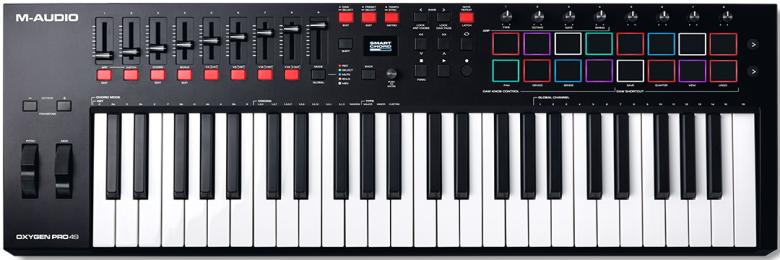

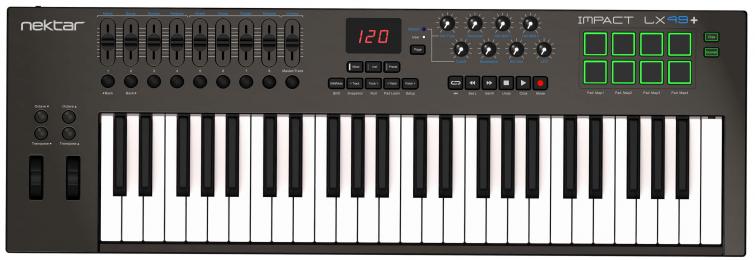

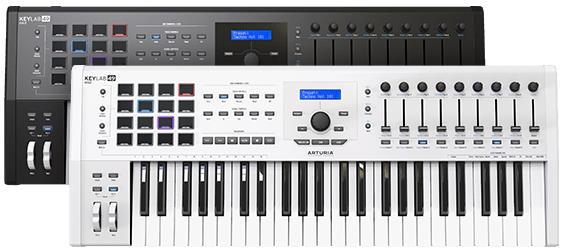
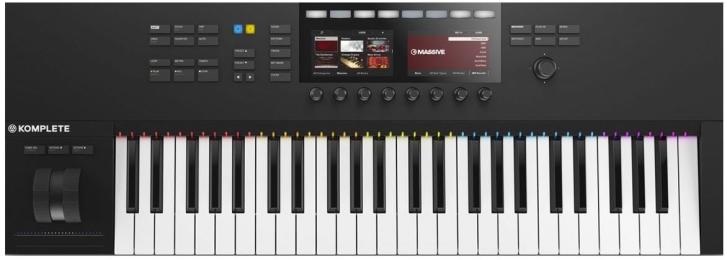
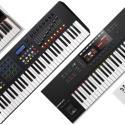
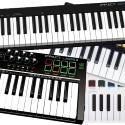
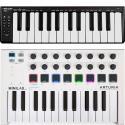
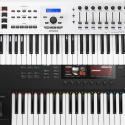
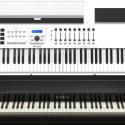
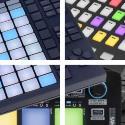
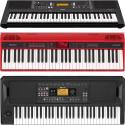
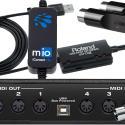
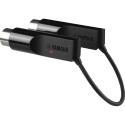
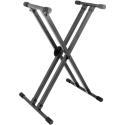
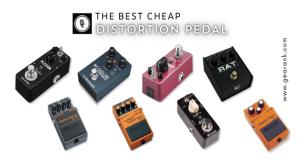

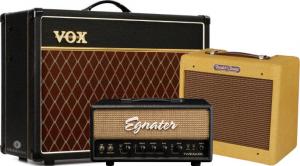
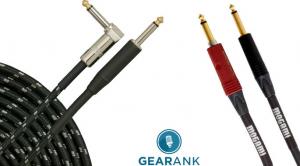
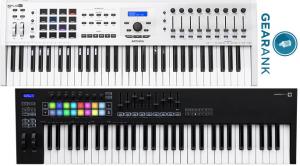
Comments
The following controllers
Submitted by Jason Horton on
The following controllers came off the recommended list above when we published the September 2022 Edition:
Publication of our May 2021
Submitted by Jason Horton on
Publication of our May 2021 Edition resulted in the following controllers coming off the recommended list above, but you can still see our analysis of them:
How can 8 keyboards with so
Submitted by Larry (not verified) on
How can 8 keyboards with so much price difference, all have gearank scores at either 89 or 90? I can't help but thinking the score is flawed and may not be much help to consumers who are trying to understand the reviewer's HONEST opinion about these products. Do they all have pretty much the same score because the reviewer is afraid of making any of the manufacturers unhappy with a lower score?
Hi Larry,
Submitted by Jason Horton on
Hi Larry,
It looks like there's a misunderstanding about what a Gearank Rating score is.
A Gearank Rating it is not a representation of our opinion about a product, it is a statistical representation of the collective opinion of the owners and users of a product and in addition to the rating number we also provide the number of sources each rating is based upon - EG: "90 out of 100. Incorporating 150+ ratings and reviews." We provide further explanation in How Gearank Works.
This is similar to how a retailer's 5 star ratings are not the opinion of the retailer, but the opinions of the people who have bought it.
The reason so many of the rating values you see above are similar is because we have only recommended the keyboards with the highest ratings. If you look at the list of 49 key controllers in our Music Gear Database, you will see that most of them have lower ratings than the ones we have recommended. We believe this helps consumers save time by only presenting the products with the best reputations.
To summarize, the reason that the items we recommend in our guides tend to have similar ratings is because we usually only recommend the items with the highest ratings, and those ratings are determined by actual owners and users rather than by our opinion.
I hope this clears up the issue, but please let me know if there's something else you'd like explained.
Jason.
Thank you for your response.
Submitted by Larry (not verified) on
Thank you for your response. I entered my original comments under the wrong assumption that Gearank provides comparison reviews without understanding "How Gearank Works" - I was researching online for midi controller reviews and came upon your site. I stand corrected - your explanation made sense to me.
As a result of our April 2020
Submitted by Jason Horton on
As a result of our April 2020 update the following came off the recommended list above, but you can still look at our analysis of them:
Korg Taktile 49 is also good
Submitted by Alper (not verified) on
Korg Taktile 49 is also good controller.
Unfortunately it's no longer
Submitted by Jason Horton on
Unfortunately it's no longer available from most retailers so you pretty much have to buy it second hand these days.
The 2017 version of this
Submitted by Jason Horton on
The 2017 version of this guide has now been published above. If you would like to read the meta-reviews of the controllers that were in the 2016 version but didn't make the list this year, then check out:
I have updated the Key
Submitted by Jason Horton on
I have updated the list of Key features for each keyboard above to include their physical dimensions - this is useful information for deciding which keyboard stand to get.
Hi, thanks for making this
Submitted by jagc (not verified) on
Hi, thanks for making this comparison review article. I know this is a "best" list according to your own statistics, but I'm very much surprised that the 2 midi controllers I'm comparing to buy one or the other right now are not in your list.
In my research, most "best" list from other sites includes "M-audio Code" and "Novation Launchkey MkII". Launchkey is even number 1 from those other sites too.
I'm very much curious why these 49 key midi controllers aren't in your list. Because if I'm convinced enough, i will buy the "Akai Professional MPK249" as that is very easy to reach right now.
Thank you for asking that
Submitted by Jason Horton on
Thank you for asking that question because it made me ask myself the same question about the Novation Launchkey 49 Mk2.
To find the answer I have reprocessed the Gearank scores with fresh data for all 16 of the 49 Key keyboard controllers in our database.
The Novation Launchkey 49 Mk2 has increased it's Gearank score to 86 which means that we can now recommend it.
On the other hand, the M-Audio Code 49 remains one of the lowest rated 49 key controllers, with a current Gearank score of only 76, so it still hasn't earned it's way into a list of controllers we would recommend.
Thanks for this excellent
Submitted by William M (not verified) on
Thanks for this excellent comparison summary. Really helpful. If you decide to do an update, a couple of other items that impact my buying considerations are whether the keyboard has a port for an expression pedal, and also the weight of the keyboard for those of us who are looking for portability. Also curious what you think of the m-audio ctrl-49 when it comes out soon.
Weights have now been added
Submitted by Jason Horton on
Weights have now been added as requested.
Thank you very much for your
Submitted by Jason Horton on
Thank you very much for your feedback.
I will put it on my to do list to add information about pedal ports and keyboard weights.
All I know about the M-Audio CTRL-49 is what I've read about it and some videos from NAMM - it certainly looks good and packed with features and I'll be looking forward to seeing how well it is received when it finally hits the stores.
It also have VIP on the
Submitted by Caleb (not verified) on
It also have VIP on the Ctrl49 that allows you to download VSTs or Presets from VSTs to be able to be used on the board standalone (perfect for musicians that don't want to have to also hook their laptop up during a live set) that means you can play straight off the MIDI controller itself
This is incorrect. You can
Submitted by Jeff (not verified) on
This is incorrect. You can control VSTs that are on you computer using VIP on the CTRL49. It does not play the VSTs as a standalone.